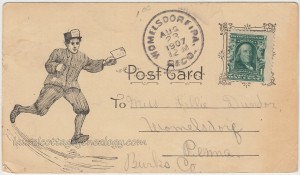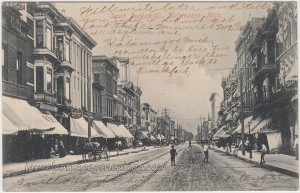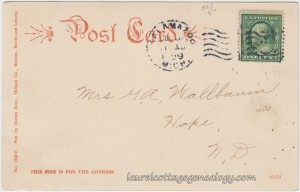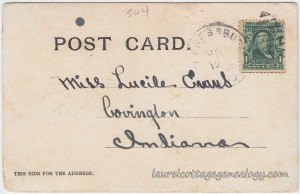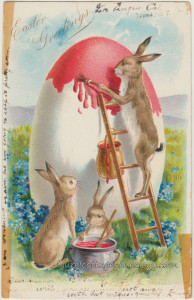

Undivided back postcard, not postmarked but with writing. Dated by the sender March 29, 1906. Card has tape yellowed with age in three of it’s four corners. Publisher: Raphael Tuck & Sons.
Availability status: SOLD
A wonderful Tuck’s scene of three brown bunnies; one is up on a ladder painting a large egg red; a second is stirring the pot of red paint, while the third looks on. The egg is nestled in grass and forget-me-nots, and the cursive Easter Greetings appears in the left top corner.
Our wandering sender, at that time in Los Angeles, dated this card March 29, 1906 and wrote, “Dear Mama McGinn. What is the matter. You never write. You are surely not angry. With best wishes. Good by. Daniel [?]” On the left side is written, “I am wandering again but I am going to stop it pretty soon.”
The card is addressed to “Mrs. J. W. McGinn, Stent. Cal., Tuolomne Co.”
The signature on the card is hard to read; it certainly starts with D-a- and the third letter is likely an n – when comparing the other n’s in the handwriting. Of course, it may be impossible to say for sure, but possibly the sender is Daniel McGinn, who appears as the son of John and Bridget McGinn on the 1870 Federal Census taken in Tuolumne County, Township 3. (Name spelled McGin.) John McGin, a miner, born Ireland about 1820, his wife, Bridget (Mrs. J. W. McGinn on the postcard?), born Ireland about 1829. Their children, ages 11 to 2 and 1/2, are Martin, W. A., Daniel, Edward, Mary, John, Margaret, Ann, M. C. and C. J….The 1900 census shows Bridget (widowed), Michael, William, Daniel, Edward, John and Annie. The older boys are all mining quartz, and the youngest boy on this census, John, is farming. The McGinn Family is one of the oldest in the district, according to a 1909 publication (Tuolumne County, California: Being a Frank, Fair and…) The 1910 census, Tuolumne County, 4th District shows Daniel (single) and living on his own, mining quartz. (So, did the wanderer settle down?)
The town of Stent was originally called Poverty Hill, and started out as a placer camp in the early 1850s. Later it became prosperous as a hardrock mining center, and also served as a supply center for many of the area’s mines. The name Poverty Hill was ironic, since it ended up producing over 15 million dollars in gold. The celebrated American author and poet Bret Harte (1836-1902) wrote about Poverty Hill, and the town is also known as the site of the famous Jumper mine, known for it’s specimen (nugget type) gold. Most accounts about Stent list the fire of 1906, (there were actually two fires in Stent’s history) but the details vary for exactly how destructive the well known ’06 fire was. A September 1, 1906 account in the Los Angeles Herald shows:
“Stent Destroyed by Fire – SONORA, Cal., Aug. 31. – Every business house in the town of Stent, three miles from Jamestown, was destroyed by fire this afternoon. Thirty-three structures were burned to the ground. The loss is estimated at $75,000. Stent at one time was one of the leading mining centers of California.”
It’s interesting to see that our postcard here was sent just about six months prior to the unfortunate ’06 blaze. Below is a photo and wonderful description and history of the town of Stent, too good not to include the whole paragraph, appearing in the aforementioned 1909 publication with the very long title (Tuolumne County, California: Being a Frank, Fair and…)
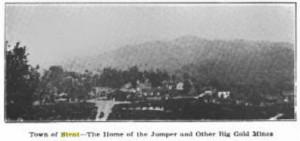
“Stent. To the Argonaut far away from and unfamiliar with the happenings in the county he once called home this name means nothing. Say ‘Poverty Hill,’ and the veil is lifted. Some of the old-timers will tell you to-day that the change from a historical name to a meaningless one was what afterward caused the star of ill fortune to twinkle malignantly over the town. Poverty Hill was a great camp in the early days, but its placer diggings were shallow and soon worked out. Then came the long lethargic period of depression that the few inhabitants withstood as best they could and which was occasionally broken by far separated reports of good ore being found in some of the quartz mines. But this rekindling of the fires of hope brought on only a bright flash, invariably followed by the flame dying down to a mere flicker. Early in the ’90s, however, came the big boom in Mother lode mines. The great Jumper, a short distance out of town, was soon ‘coughing up’ a stream of gold, other claims were paying, people flocked in, buildings were hurried up and soon a lively little city was on the map. Then came the serious mistake of formally re-christening the place Stent, after a mining man who apparently occupied the topmost position on the wave of prosperity. Later the step was regretted. Twice the town was visited by disastrous fires, the two very nearly wiping it out. It is now but a shadow of its former self, but the people still there are of a good class and will be early on the ground when the next boom hits Stent, as sooner or later it must.”
Sources: http://www.malakoff.com/goldcountry/stent.htm
http://tchistory.org/TCHISTORY/Jamestown.htm
http://cdnc.ucr.edu/cgi-bin/cdnc?a=d&d=LAH19060901.2.11
Los Angeles Herald, Vol. 33, Number 336. 1 September 1906. (California Newspaper Digital Collection) http://cdnc.ucr.edu/cgi-bin/cdnc?a=d&d=LAH19060901.2.11#
Tuolumne County, California: Being a Frank, Fair and Accurate Exposition, Pictorially and Otherwise, of the Resources and Possibilities of This Magnificent Section of California. J. A. Van Harlingen & Co., Printers and Publishers, Sonora, California. Copyrighted 1909 by the Union Democrat, Sonora, California. (Google eBook)
Ancestry.com. California, Voter Registers, 1866-1898 [database on-line]. Provo, UT, USA: Ancestry.com Operations, Inc., 2011. Original data: Great Registers, 1866–1898. Microfilm, 185 rolls. California State Library, Sacramento, California.
Year: 1870; Census Place: Township 3, Tuolumne, California; Roll: M593_93; Page: 365A; Image: 129; Family History Library Film: 545592. Year: 1900; Census Place: Township 6, Tuolumne, California; Roll: 116; Page: 11B; Enumeration District: 0130; FHL microfilm: 1240116. Year: 1910; Census Place: Township 4, Tuolumne, California; Roll: T624_111; Page: 1A; Enumeration District: 0168; FHL microfilm: 1374124.(Ancestry.com)


